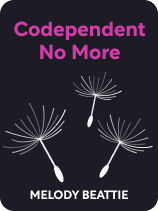

This article is an excerpt from the Shortform book guide to "Codependent No More" by Melody Beattie. Shortform has the world's best summaries and analyses of books you should be reading.
Like this article? Sign up for a free trial here .
Are you looking to better yourself? What are some examples of development goals that you should set for yourself?
Setting personal development goals for yourself requires focusing on yourself and acknowledging your needs. For that reason, many people have a difficult time setting personal goals and following through with them. These goals are especially useful for people who struggle with codependency and self-esteem.
Here are eight examples of good goals to set for yourself this year.
Goal #1: Find Balance
These examples of development goals are mostly inspired by Melody Beattie’s book Codependent No More. In her book, Beattie maintains that the most important goal for codependents is finding balance, primarily in how you give and receive love. Everyone needs love, but you can’t allow that need to overpower your other needs: Give and receive love while still living your own life and looking forward to your future.
Usually, Beattie explains, finding balance in love requires a recalibration of how you search for love. Unhealthy relationships make you trade your life for the other person’s care and affection. When you have become used to this kind of relationship, changing how you search for love seems impossible.
So how do you find that balance? Beattie says you must be honest about your unhealthy relationships, challenge your ingrained beliefs about relationships, and change your actions to match. For example, Jane admits that her relationship with her boyfriend is unhealthy: She’s given up her own life to keep the relationship. She challenges her ingrained belief (that she has to give up everything to be a good partner) by reciting self-love affirmations, and she changes her behavior by restarting her other activities and refusing to drop them for her boyfriend.
| Why You Fall Into Unhealthy Relationships and How to Avoid Them Beattie says that past experience and ingrained beliefs cause you to lose yourself in unhealthy relationships. Another reason is that you have come to associate intensity with intimacy. In the first few weeks of a relationship, you throw yourself in headfirst, abandoning other responsibilities or activities for your partner. The intensity of feelings and the speed of the relationship makes you feel like you’re gaining intimacy, which makes it hard to be honest with yourself. You think intensity means things are going well, when in reality a true foundation of trust and intimacy takes time. Beattie suggests challenging your ingrained beliefs to maintain healthy relationships. These are also called limiting beliefs: negative thought patterns that change how you think about yourself and your relationships. Thoughts like “this is the only kind of love I’ll ever find,” damage your self-confidence and make you more likely to settle for unhealthy relationships. Here are a few ideas for avoiding these pitfalls and changing your behavior, as Beattie suggests: 1. Take your relationship slow to build true intimacy. 2. Don’t sacrifice the rest of your life for the relationship. Maintain your other responsibilities, interests, and hobbies. 3. Challenge your limiting beliefs. Track down the sources of these beliefs and see if they actually make sense. 4. Be active in caring for yourself and making decisions that make you happy. Focus on yourself as an individual, not as just half of a relationship. |
Goal #2: Have Fun
Fun is hard for codependents, Beattie states. When you have spent so long believing that you don’t matter, you think you don’t deserve to have fun and feel guilty for taking time for yourself. However, fun is vital for enjoying life. Fun allows you to celebrate the good in the world and encourages you to keep living and healing.
Taking time for yourself and doing activities you enjoy will get easier the more you practice, Beattie explains. If you’re not sure what you enjoy doing, adjust the goal to finding those things. Try lots of different activities and explore with an open mind.
| The Importance of Fun Beattie believes fun is important, but is it really? In A Theory of Fun For Game Design, Raph Koster defines fun as a hit of dopamine from learning something or mastering a new skill. That dopamine, along with its fellow serotonin, helps decrease unhealthy stress hormones like cortisol. This makes you happier and more hopeful, and lets you see the good things in life. It also improves sleep, blood pressure, and memory. In addition, doing fun activities increases creativity, curiosity, and productivity. So yes, it’s very important. Start easy in your search for fun, with things that you find interesting and tasks you know you can do. Starting with minimal challenge will give you the mental space to overcome feelings of discomfort and will guarantee you the hit of dopamine Koster references. Once you become more comfortable, you can challenge yourself by exploring different activities. |
Goal #3: Set Strong Boundaries
Boundaries are also difficult for codependents, but setting strong boundaries is vital to living your own life, Beattie argues. Having weak boundaries leads you to be overly tolerant for a long time before hitting a peak of anxiety and stress, after which you become intolerant even of normal human behavior and mistakes. (Shortform note: Weak boundaries leave you open to being hurt by other people. After you reach a peak of hurt, your weak boundaries become rigid, with no understanding or compassion.)
Beattie suggests watching your reactions. Find a healthy balance of maintaining your boundaries while understanding that people are not perfect. Communicate your boundaries clearly, and then hold them firmly. Don’t let people guilt you, ignore your boundaries, or try to adjust your boundaries.
(Shortform note: Some people argue that your boundaries should be flexible, but only in certain circumstances. You might clear your schedule when a family member ends up in the hospital, for example, but not in everyday life. You might also give leeway when your family is adjusting to setting and respecting boundaries, but everyone must have the intention of learning, rather than weakening each other’s boundaries.)
| How to Set Healthy Boundaries Research supports Beattie’s assertion that setting strong boundaries is important. There are five kinds of boundaries, all of which are important for living your own life: physical, sexual, intellectual, emotional, and financial. Each kind of boundary needs to be strong. Here are a few tips for strengthening them: 1. Reflect on your current boundaries or ones you are thinking of setting. Figuring out why they’re important to you will help you maintain them. 2. Set boundaries early in new relationships. If your partner won’t respect your boundaries right off the bat, it’s probably not a healthy relationship. 3. Create a “framework” for your boundaries. A framework is made of repeating activities that enforce your boundaries. For example, scheduling an hour of alone time every weekend or deciding you won’t respond to work messages after hours. |
Goal #4: Practice Healthy Intimacy
According to Beattie, intimacy feels dangerous for many codependents. They might have been hurt by an intimate partner, or they might have never learned how to form intimate relationships. Some people are so used to unhealthy relationships that a lack of intimacy has become a habit. However the lack of intimacy came about, it causes limited relationships that make you feel distant and isolated from your loved ones.
(Shortform note: Beattie’s description of a fear of intimacy mirrors the traits of anxious-avoidant attachment, where you crave intimacy but are afraid of it. To overcome this fear, look at the facts of a situation when you start worrying, pay attention to how and when you push people away, and work on mutual support, rather than caretaking or relying only on yourself.)
In a way, Beattie adds, codependents are right: Intimacy is a risk. It’s showing someone your most vulnerable parts and hoping they don’t reject you. But codependents tend to think that they must avoid this pain even at the cost of relationships. Rejection is not the end of the world. You can handle your emotions, heal, and move on to better relationships. It is possible to find people who will love you, and it is possible to love people in return.

———End of Preview———
Like what you just read? Read the rest of the world's best book summary and analysis of Melody Beattie's "Codependent No More" at Shortform .
Here's what you'll find in our full Codependent No More summary :
- What inspired codependency 12 Step Programs around the country
- Explanations, advice, and compassion for people struggling with codependency
- How to practice detachment, self-care, and personal responsibility






